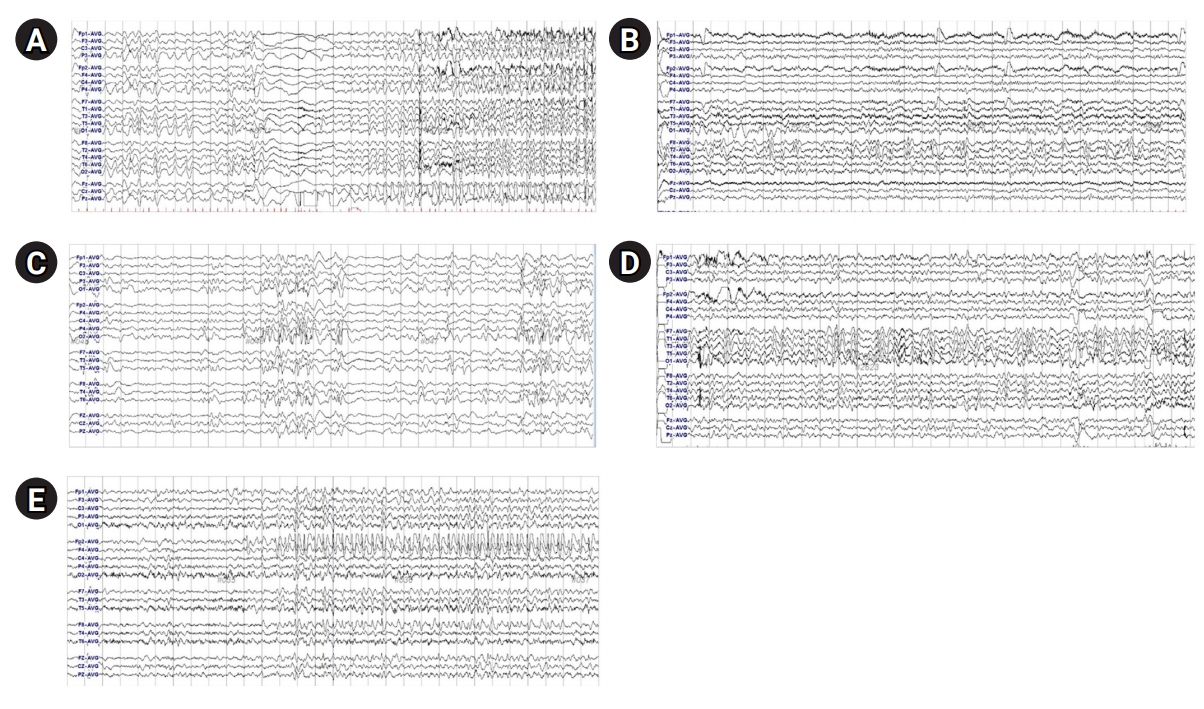 |
 |
- Search
| Ann Child Neurol > Volume 29(2); 2021 > Article |
|
Abstract
Purpose
Methods
Results
Conflicts of interest
Jieun Choi is an associate editor, Ki Joong Kim and Jong-Hee Chae are the editorial board members of the journal, but They was not involved in the peer reviewer selection, evaluation, or decision process of this article. No other potential conflicts of interest relevant to this article were reported.
Notes
Author contribution
Conceptualization: WJK and JHC. Data curation: WJK, YKS, YJK and SYK. Formal analysis: WJK and YKS. Funding acquisition: KJK and JHC. Methodology: WJK and YKS. Project administration: HK, BCL HH, JC, and JHC. Visualization: WJK and YJK. Writing-original draft: WJK. Writing-review & editing: BCL, KJK, and JHC.
Acknowledgments
Fig. 2.

Table 1.
| Variable | P1 | P2 | P3 | P4 | P5 | P6 | P7 | P8 | P9 | P10 |
|---|---|---|---|---|---|---|---|---|---|---|
| Sex/age | F/7 years | F/5 years | F/3 years | M/7 years | F/1 year | M/11 years | F/8 years | F/2 years | F/3 years | M/3 years |
| Seizure onset | 3 days | 13 months | 3 months | 24 months | 10 days | 7 years | Never | 10 days | 2 months | 2 months |
| Seizure type | T | Ba, T | T, Es, My, At | T, Ba | T, Es | My | NA | T, Es | T, GTC | Es |
| Seizure frequency | Daily→weekly | Daily→weekly | Weekly→monthly | Weekly→Frequent daily | Daily→Daily | Monthly | Never | Frequent daily→weekly | Daily→Monthly | Daily→Seizure-free |
| EEG | B-S with multifocal spikes→focal spikes | Focal and generalized spikes | B-S with multifocal spikes→H | Focal spikes | B-S with multifocal spikes→H | Focal spike | Diffuse background slowing | B-S with multifocal spikes | Focal spikes | Focal spikes |
| Diffuse background slowing | Focal slowing | Focal slowing | ||||||||
| Brain MRI | Normal | Normal | Normal | Normal | Normal | Normal | Normal | Normal | Normal | Normal |
| DD before seizure | NA | No | No | Yes | NA | Yes | Yes | NA | No | No |
| Regression | No | No | No | No | No | Yes (after seizure onset) | Yes | No | No | No |
| Neurologic state at the last follow-up | Severe GDD | Few words, climbed stairs | Pointed to objects, walked while holding | No word output, walked alone | Severe GDD | No word output but walked alone→bedridden state | Rolled over, babbling→bedridden state, no word output | Bedridden state, no eye contact | Severe GDD, standing up by self | Severe GDD, bedridden state |
| Other symptoms | None | Hyperactivity, disruptive behavior | None | Hyperactivity, disruptive behavior | None | Hyperactivity, disruptive behavior | Head tremor, dyskinesia, bruxism, hand stereotypy | Truncal dystonia, hypotonia | Bruxism, hand stereotypy | None |
| ataxia, tremor | ||||||||||
| AEDs | LEV, CNZ, VPA | VPA, LEV, OXC, TPM | VPA, VGB, LEV | VPA, LEV, LTG,OXC | VPA, VGB, LEV, LCS, LTG | TPM, LEV, CLB, VPA | None | LEV, VGB, CLB | VPA, CLB | None |
| Clinical diagnosis | EIEE → EE, unspecified | EE, unspecified | EIEE → WS | EE, unspecified | EIEE → WS | EE, unspecified | Rett syndrome | EIEE | EE, unspecified | EE, unspecified |
| Variant/previous report | c.703C>T, reported [11] | c.1212A>C, novel | c.1099C>T, reported [3] | c.1651C>T, reported [13] | c.88-2A>G, reported [14] | c.1497C>G, novel | c.1439C>T, reported [12] | c.1030-2 A>G | c.1162C>T, reported [15] | c.1631G>T, reported [16] |
| Segregation | De novo | De novo | De novo | De novo | De novo | De novo | De novo | NA | NA | De novo |
| Pathogenicity (ACMG criteria) | Pathogenic (PVS1, PS2, PM2, PP3, PP5) | Likely pathogenic (PS2, PM2) | Pathogenic (PVS1, PS2, PM2, PP3, PP5) | Pathogenic (PS2, PM1, PM2, PP3, PP5) | Pathogenic (PVS1, PS2, PM2, PP3, PP5) | Pathogenic (PVS1, PS2, PM2) | Pathogenic (PS2, PM1, PM2, PP3, PP5) | Pathogenic (PVS1, PM2, PP3) | Pathogenic (PVS1, PM2, PP5) | Pathogenic (PS2, PM1, PM2, PP3, PP5) |
STXBP1, syntaxin-binding protein 1; T, tonic; Ba, behavior arrest; Es, epileptic spasm; My, myoclonic; At, atonic; NA, not available; GTC, generalized tonic-clonic; EEG, electroencephalography; B-S, burst-suppression; H, hypsarrhythmia; MRI, magnetic resonance imaging; DD, developmental delay; GDD, global developmental delay; AED, antiepileptic drug; LEV, levetiracetam; CNZ, clonazepam; VPA, valproic acid; OXC, oxacarbazepine; TPM, topiramate; LTG, lamotrigine; VGB, vigabatrin; LCS, lacosamide; CLB, clobazam; EIEE, early infantile epileptic encephalopathy; EE, epileptic encephalopathy; WS, West syndrome; ACMG, American College of Medical Genetics; PVS, pathogenic very strong; PS, pathogenic strong; PM, pathogenic moderate; PP, pathogenic supporting.
References
- TOOLS
-
METRICS

-
- 0 Crossref
- Scopus
- 4,564 View
- 150 Download
- Related articles in Ann Child Neurol
-
Clinical and Genetic Spectrum of Tubulinopathy: A Single-Center Study 2024 April;32(2)
Expanding the Clinical and Genetic Spectrum of Caveolinopathy in Korea2022 July;30(3)
Clinical Spectrum of Posterior Reversible Encephalopathy Syndrome in Children2020 April;28(2)
Predictive and Prognostic Factors of Viral Encephalitis in Pediatric Patients.2017 June;25(2)







